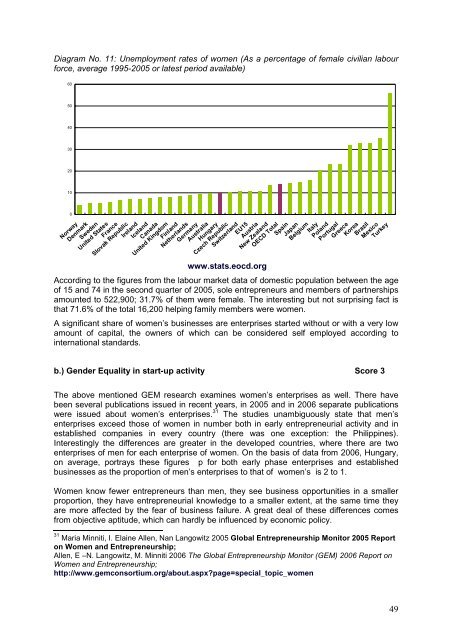Gender Equality National Report Hungary - European-microfinance ...
Gender Equality National Report Hungary - European-microfinance ...
Gender Equality National Report Hungary - European-microfinance ...
You also want an ePaper? Increase the reach of your titles
YUMPU automatically turns print PDFs into web optimized ePapers that Google loves.
Diagram No. 11: Unemployment rates of women (As a percentage of female civilian labour<br />
force, average 1995-2005 or latest period available)<br />
60<br />
50<br />
40<br />
30<br />
20<br />
10<br />
0<br />
Norway<br />
Denmark<br />
Sweden<br />
United States<br />
France<br />
Slovak Republic<br />
Ireland<br />
www.stats.eocd.org<br />
Iceland<br />
Canada<br />
United Kingdom<br />
Finland<br />
Netherlands<br />
Germany<br />
Australia<br />
<strong>Hungary</strong><br />
Czech Republic<br />
Switzerland<br />
EU15<br />
Austria<br />
New Zealand<br />
OECD Total<br />
Spain<br />
Japan<br />
Belgium<br />
Italy<br />
Poland<br />
Portugal<br />
Greece<br />
Korea<br />
Brazil<br />
Mexico<br />
Turkey<br />
According to the figures from the labour market data of domestic population between the age<br />
of 15 and 74 in the second quarter of 2005, sole entrepreneurs and members of partnerships<br />
amounted to 522,900; 31.7% of them were female. The interesting but not surprising fact is<br />
that 71.6% of the total 16,200 helping family members were women.<br />
A significant share of women’s businesses are enterprises started without or with a very low<br />
amount of capital, the owners of which can be considered self employed according to<br />
international standards.<br />
b.) <strong>Gender</strong> <strong>Equality</strong> in start-up activity Score 3<br />
The above mentioned GEM research examines women’s enterprises as well. There have<br />
been several publications issued in recent years, in 2005 and in 2006 separate publications<br />
were issued about women’s enterprises. 31 The studies unambiguously state that men’s<br />
enterprises exceed those of women in number both in early entrepreneurial activity and in<br />
established companies in every country (there was one exception: the Philippines).<br />
Interestingly the differences are greater in the developed countries, where there are two<br />
enterprises of men for each enterprise of women. On the basis of data from 2006, <strong>Hungary</strong>,<br />
on average, portrays these figures p for both early phase enterprises and established<br />
businesses as the proportion of men’s enterprises to that of women’s is 2 to 1.<br />
Women know fewer entrepreneurs than men, they see business opportunities in a smaller<br />
proportion, they have entrepreneurial knowledge to a smaller extent, at the same time they<br />
are more affected by the fear of business failure. A great deal of these differences comes<br />
from objective aptitude, which can hardly be influenced by economic policy.<br />
31<br />
Maria Minniti, I. Elaine Allen, Nan Langowitz 2005 Global Entrepreneurship Monitor 2005 <strong>Report</strong><br />
on Women and Entrepreneurship;<br />
Allen, E –N. Langowitz, M. Minniti 2006 The Global Entrepreneurship Monitor (GEM) 2006 <strong>Report</strong> on<br />
Women and Entrepreneurship;,<br />
http://www.gemconsortium.org/about.aspx?page=special_topic_women<br />
49















![Joint Report on Social Protection and Social Inclusion [2005]](https://img.yumpu.com/19580638/1/190x132/joint-report-on-social-protection-and-social-inclusion-2005.jpg?quality=85)
